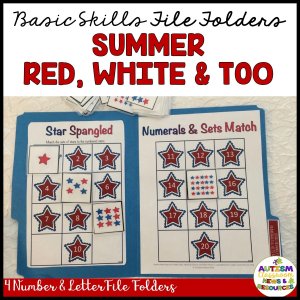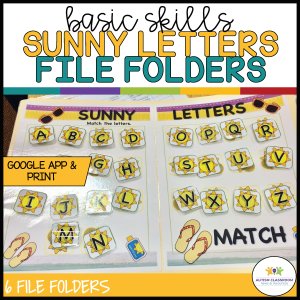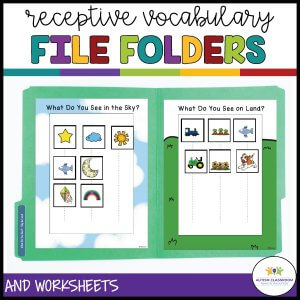Product Description
If you are looking for engaging materials for students to work on all kinds of receptive language and category sorting, this set of file folders and worksheets are perfect for you. Using file folder activities with simple illustrations, students will sort between multiple categories including clothes, animals, food, and furniture. Students will also sort by characteristics (e.g., live on land or water).
✅ 7 Vocabulary sort file folder activities included (or 14 single-page activities):
- Animals that live on land and in the water
- What do you see in the sky and on land
- What do you see in the ocean and in the sky
- What belongs at the beach and in the classroom
- What belongs on the playground and in the classroom
- Sorting Animals, furniture, clothes, and food —these can be set up as 2 file folders, as 4 separate binder pages to increase the field of sorting up to 4, or could be printed several times to develop 6 file folders of 2-category sorting of: animals / furniture; animals / clothes; animals / food; furniture / clothes; furniture / food; clothes / food
✅ You will love the…
- Multiple Ways to Use – Create special education file folder games or laminate individual vocabulary sort activities and store in a binder
- Easy Differentiation – mix and match the receptive language categories or have the student sort across multiple categories (e.g., clothes, animals, food and furniture)
✅ Need permanent work samples to demonstrate mastery of these receptive language vocabulary skills?
This resource also includes 22 vocabulary sorting worksheets!
- Students cut and paste vocabulary pictures into the right column
- Picture cues included
- Color worksheets also print well in black and white to save ink
- Allows students to demonstrate mastery in a permanent product you can save for their records
✅ DOWNLOAD THE PREVIEW for a FREE sample worksheet.
❤️ What are teachers saying…
⭐️⭐️⭐️⭐️⭐️ “This was a helpful resource for students to practice their sorting and identification skills. The resource was also helpful in identifying animals, objects, and things by similar and different attributes.” – Benjamin L.
⭐️⭐️⭐️⭐️⭐️ “This is an excellent resource! I have been able to use it with kindergarten students and adapt it to our students with ASD in other grade levels. Thank you!” – Mary Beth M.
⭐️⭐️⭐️⭐️⭐️ “You create such great activities. I love the graphics and that they don’t seem “baby-ish” for older students. Most of all, you address subjects that are difficult for me to teach, like science for example. I get your emails and they are always so helpful and encouraging. Thanks again. Keep up the good work!” – Doranne B.
Students with autism and other language delays and disorders need explicit instruction in receptive language and vocabulary beyond simply naming items. One way that we address this is to work on receptive language and expressive characteristics of items and actions. Specifically we work on features (i.e., adjectives like color, size etc.), function (i.e., what we use it for) and class (i.e., categories it can fall into). This set of activities was developed to help students practice receptive language in a variety of ways in addition to the explicit instruction of them. Teaching vocabulary using a variety of materials and interventions is important to assure that students generalize their skills.
For more ideas for working with students with autism, check out my blog at Autism Classroom News.
© Christine Reeve
This product is copyrighted to Autism Classroom News-Christine Reeve 2019 for use in one classroom. They may not be copied for additional classes without purchasing extra licenses.






